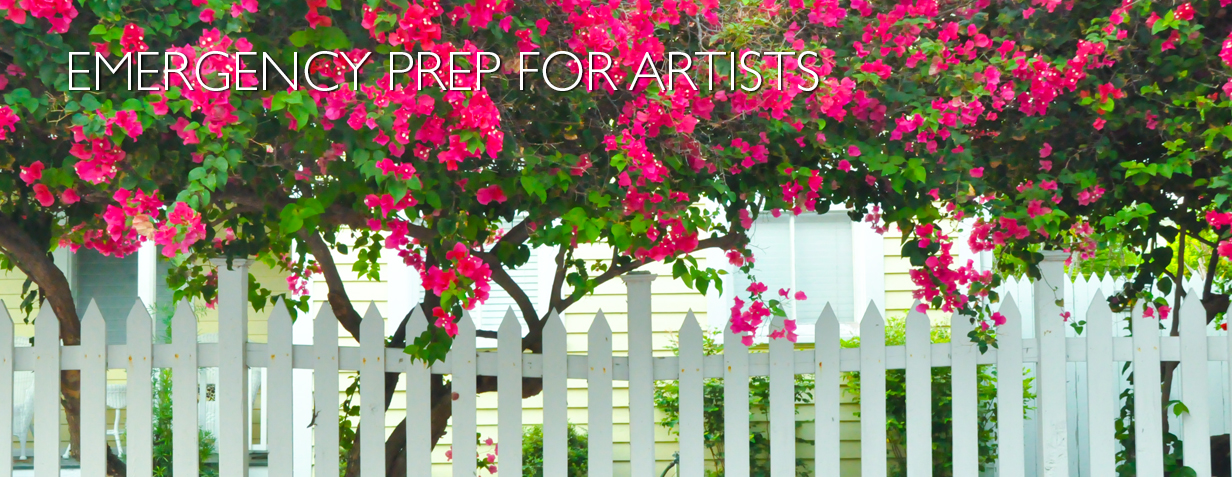
If you have been thinking that you need to prepare yourself and make a disaster plan, put together a disaster kit, and do some things to prepare your studio for emergencies but just haven’t gotten around to it yet. Don’t put it off any longer.
The outline below was put together by the Craft Emergency Relief Fund (www.craftemergency.org ) with artists in mind. This is a summary that will help you prepare for several kinds of emergencies. The Craft Emergency Relief Fund provides detailed step-by-step instructions and checklists should you need more practical information. They created the Studio Protector Online Guide available at www.studioprotector.org.
Take your first emergency preparedness steps today. The more complete your preparation, the more likely your business will recover from an emergency.
Secure your Studio
Take steps to reduce physical destruction to your buildings and contents. The following steps can reduce your insurance costs as well:
• Even if you rent your studio there are steps you can take to strengthen and protect the building in the event of an emergency.
• Make a prioritized list of business items you would need to take with you in case you needed to leave in a hurry. Make the items easily accessible and properly protected.
Communications Plan
Before an emergency occurs reach out to those who care about you and let them know where you would evacuate to in the event of an emergency and how they can stay in contact with you.
• Designate one person outside of your geographic are that you will stay in contact with so that others can call this person to check on you.
• If you have employees, let them know how to get in touch with you if an emergency occurs. Encourage them to have emergency plans of their own.
Insurance
Even with homeowners and business insurance coverage, emergency recovery is a major undertaking. Don’t consider insurance an “all or nothing” proposition; at the very least get your basics properly insured.
• Make sure you understand what is and is not covered by your homeowners or renters insurance. Be aware that it will cover little or none of your business property.
• If you don’t have business property insurance, review your risks and learn about the insurance options available to you.
• Property insurance will not cover flood damage. Use the resources listed at the end of this outline to learn more about flood insurance.
Protect Critical Information
Insurance policies, legal papers, contact lists, financial records, inventory lists, and photographs of property are some examples of critical information you will need to access after an emergency. Protect the originals and have duplicates at a safe off site location.
• Computer Backups – Do periodic backups of your hard drive. Store your backups at a safe off site location. If you have access to a high-speed Internet connection, online backups are a good option.
• Studio Pictures – Videotape or photograph your entire studio and do this periodically as you are likely to acquire more things over time. Store this documentation in a safe off site location. It will be a critical component to the success of your insurance claim.
• Important Papers – Insurance policies, contracts, and tax records are usually key items to have copies of in safe off site location. As an artist, you are likely to have critical documents about your work and/or your process, such as glaze formulas for ceramic artists. Don’t assume that you’ll be able to grab these important documents on your way out the door when an emergency occurs.
• Art Pictures – A photographic history of your art is important; especially so after an emergency. If your portfolio is recorded using traditional photography, make sure the originals are stored in a safe off site location. Having digital images of your work offers more options. A few inexpensive CD’s can hold high-resolution versions of complete portfolios. Online archiving is a good option.
Protect Critical Inventory
At any time, your artwork may be in a variety of locations – galleries, museums, shows, in transit, storage, or in your studio. Beyond insuring the items, take reasonable steps to protect them from damage in the event of an emergency.• If you have artwork in galleries, museums or at shows ask the staff if your artwork is covered by their insurance in the event of an emergency. If it’s not, take care of this risk yourself.
• Understand your risk exposure for where you live and plan accordingly. For example, if flooding is possible, protect your work from above and below. Even if you have taken measures to protect your business, an emergency can keep you from making and selling your work for an extended period of time. The following steps can reduce your downtime:
• Establish a mutual aid understanding with an artist in another region so that if an emergency occurs, you have a place where you could work.
• Don’t depend on one locale or market for selling your work. Be as diverse as you can so that if one locale/market is down you have other options.
• Minimize your downtown by knowing the insurance claim process.
• Government relief agencies such as FEMA and SBA are there to help you recover. Take full advantage of their services by being thorough and persistent when working with them.
• Consider purchasing certain kinds of equipment such as a portable generator so that you can return to work as quickly as possible.
• If you are highly dependent on a few suppliers for your raw materials, have some back up sources as well in case your critical suppliers are affected by an emergency.
• Consider purchasing business interruption insurance. It will cover your lost revenue during recovery.
